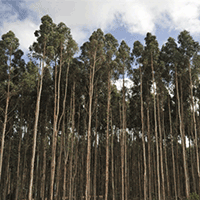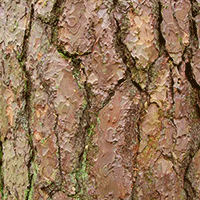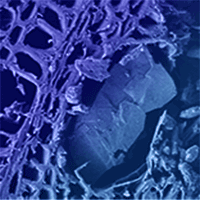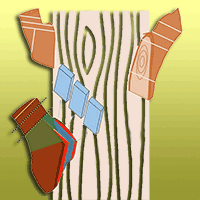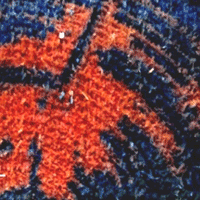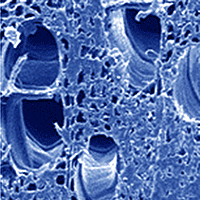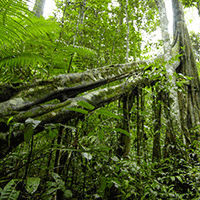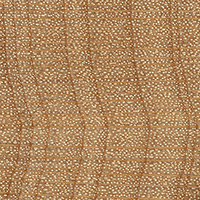
Effect of stand density on longitudinal variation of wood and bark growth in fast-growing Eucalyptus plantations
Fernanda Maria Guedes Ramalho (1), Emanuella Mesquita Pimenta (1), Caio Palmeira Goulart (1), Maria Naruna Félix De Almeida (2), Graziela Baptista Vidaurre (2), Paulo Ricardo Gherardi Hein (1)
iForest - Biogeosciences and Forestry, Volume 12, Issue 6, Pages 527-532 (2019)
doi: https://doi.org/10.3832/ifor3082-012
Published: Dec 12, 2019 - Copyright © 2019 SISEF
Research Articles
Abstract
The influence of tree spacing on the wood/bark ratio is unknown in young fast-growing Eucalyptus trees. The objective of this study was to evaluate the effect of plant spacing on the wood and bark production along the Eucalyptus stem. Four genetic materials were planted in four spacings: 3×1 m, 3×2 m, 3×3 m and 3×4 m. Three 5-year-old trees from each clone and in each plant spacing were harvested. Cross-sectional discs (thickness: 30 mm) were cut from each tree along the stem (0%, 25%, 50%, 75% and 100% of the total tree height) and at 1.3 m above ground, totaling 288 disks (4 spacings × 4 clones × 3 replicates × 6 axial positions). The wood thickness was measured at six random and equidistant points around the perimeter using a gauge and means were calculated from each disc. Six cross diameters were measured for each debarked disc. After obtaining the averaged bark thickness and wood diameter, the bark content was calculated as the ratio between the surface area occupied by the bark and the total area of the stem in each level. In the narrowed plant spacing (3×1), the trees had a mean diameter of 7.4 cm, while at the spacing 3×4 the diameter of the trees was 91% higher (14.11 cm) at breast height. The increase in plant spacing from 3 to 12 m2 per tree resulted in an increase in bark thickness (56.7%) from 1.94 mm to 3.04 mm, but caused a reduction of bark content (16%) from 9.66% to 8.11%. Our findings show that trees grown under wider spacing tend to produce thicker bark. The bark thickness and the effect of plant spacing on the bark thickness decreased in the base-top direction. The correlation between bark thickness and wood diameter increases from 0.682 to 0.825 with the increase of spacing between trees. In contrast, the bark thickness to bark content correlation decrease from 0.735 to 0.15 with increased plant spacing. The stand density significantly affected the variation of the stem diameter, bark thickness and bark content of Eucalyptus plantations.
Keywords
Stand Density, Timber, Bark, Silvicultural Treatment, Forest Productivity
Authors’ Info
Authors’ address
Emanuella Mesquita Pimenta
Caio Palmeira Goulart
Paulo Ricardo Gherardi Hein 0000-0002-9152-6803
Federal University of Lavras, Department of Forest Science, Lavras, CP37, 37200-000 (Brazil)
Graziela Baptista Vidaurre 0000-0001-9285-7105
Federal University of Espírito Santo, Department of Forest Science, Jerônimo Monteiro, 29550-000 (Brazil)
Corresponding author
Paper Info
Citation
Ramalho FMG, Pimenta EM, Goulart CP, De Almeida MNF, Vidaurre GB, Hein PRG (2019). Effect of stand density on longitudinal variation of wood and bark growth in fast-growing Eucalyptus plantations. iForest 12: 527-532. - doi: 10.3832/ifor3082-012
Academic Editor
Roberto Tognetti
Paper history
Received: Feb 25, 2019
Accepted: Aug 31, 2019
First online: Dec 12, 2019
Publication Date: Dec 31, 2019
Publication Time: 3.43 months
Copyright Information
© SISEF - The Italian Society of Silviculture and Forest Ecology 2019
Open Access
This article is distributed under the terms of the Creative Commons Attribution-Non Commercial 4.0 International (https://creativecommons.org/licenses/by-nc/4.0/), which permits unrestricted use, distribution, and reproduction in any medium, provided you give appropriate credit to the original author(s) and the source, provide a link to the Creative Commons license, and indicate if changes were made.
Web Metrics
Breakdown by View Type
Article Usage
Total Article Views: 42795
(from publication date up to now)
Breakdown by View Type
HTML Page Views: 36504
Abstract Page Views: 3151
PDF Downloads: 2465
Citation/Reference Downloads: 9
XML Downloads: 666
Web Metrics
Days since publication: 2194
Overall contacts: 42795
Avg. contacts per week: 136.54
Citation Metrics
Article Citations
Article citations are based on data periodically collected from the Clarivate Web of Science web site
(last update: Mar 2025)
Total number of cites (since 2019): 15
Average cites per year: 2.14
Publication Metrics
by Dimensions ©
Articles citing this article
List of the papers citing this article based on CrossRef Cited-by.
References
Anatomia da madeira [Wood anatomy]. Nobel, São Paulo, Brazil, pp. 154. [in Portuguese]
Gscholar
Anuário estatístico da Indústria Brasileira de Arvores: ano base 2016 [Statistical yearbook of the Brazilian tree industry: base year 2016]. IBA - Indústria Brasileira de Árvores, Brasília, Brazil, pp. 77. [in Portuguese]
Gscholar
Effects of pretreatment on morphology, chemical composition and enzymatic digestibility of Eucalyptus bark: a potentially valuable source of fermentable sugars for biofuel production - part 1. Biotechnology for Biofuels 6: 75.
CrossRef | Gscholar
Chemical composition and wood anatomy of Eucalyptus globulus clones: variations and relationships with pulpability and handsheet properties. Journal of Wood Chemistry and Technology 29 (1): 43-58.
CrossRef | Gscholar
Influence of contrasting stocking densities on the dynamics of above-ground biomass and wood density of Eucalyptus benthamii, Eucalyptus dunnii, and Eucalyptus grandis for bioenergy in Uruguay. Forest Ecology and Management 438: 63-74.
CrossRef | Gscholar
Effect of plant spacing on the physical, chemical and energy properties of Eucalyptus wood and bark. Journal of Tropical Forest Science 28 (3): 243-248.
Gscholar
Genetics of wood production. Springer-Verlag, Berlin, Germany, pp. 336.
Gscholar

